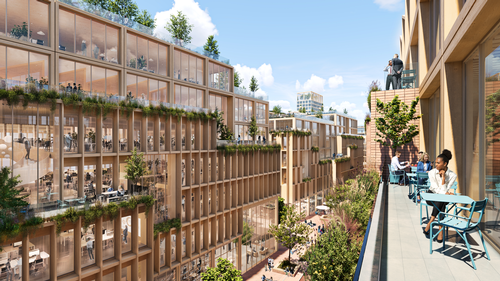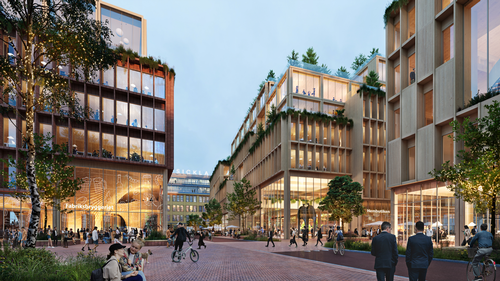THURSDAY, JUNE 22, 2023
Earlier this week, residential property management company Atrium Ljungberg announced what it is calling the world’s largest urban construction project in wood in Stockholm, Sweden.
“We are proud to introduce Stockholm Wood City. This is not only an important step for us as a company, but a historic milestone for Swedish innovation capability," said Annica Ånäs, CEO of Atrium Ljungberg.
“Stockholm Wood City manifests our future. From tenants, there is a strong demand for innovative, sustainable solutions—a demand that we meet with this initiative.”
About the Project
According to the press release, the project will extend over 250,000 square meters (2,690,977 square feet) and will feature 7,000 office spaces and 2,000 homes in Sickla. Additionally, plans include a “vibrant, urban environment” with a mix of workplaces, housing, restaurants and shops.
Reports indicate that the area is currently an old industrial zone filled with former factory buildings and parking lots. The mass-timber development will span 25 blocks with 30 wood buildings.
Mass timber, including panels and beams made from layers of wood stacked together for extra strength, has been shown to reduce the carbon footprint of other construction materials like concrete and steel. While it has been reported that the number of buildings using the material is quickly growing, projects typically happen one building at a time.

 |
| Photos: Atrium Ljungberg |
|
Earlier this week, residential property management company Atrium Ljungberg announced what it is calling the world’s largest urban construction project in wood in Stockholm, Sweden. |
“Our core strategy is to develop large interconnected areas,” Ånäs said. “In this way, we can create places full of variety that people enjoy and where they want to be, as opposed to just setting up a single building.”
Various studies, the company says, have also shown that wooden buildings provide better air quality, reduce stress, increase productivity and store carbon dioxide throughout the time they are in use.
Atrium Ljungberg reports that, in addition to the wood advantages, the project features several other environmental benefits. The project will also focus on self-produced, stored and shared energy, as well as investing in resource-efficient construction methods and circular material flows.
Office spaces are reportedly aimed to meet the deficit in workplaces south of the inner city, as well as shorten commuting times and support the idea of a “15-minute city.” A new subway line is also anticipated to be opened in the city.
 |
|
According to the press release, the project will extend over 250,000 square meters (2,690,977 square feet) and will feature 7,000 office spaces and 2,000 homes in Sickla. |
“Our industry leaves a big mark, and it is important for us to make a positive difference in both the shorter and longer term,” continued Ånäs. “We want to create an environment where our customers, those who will live and work here, can participate in the development and design of the city district of the future.”
Work is expected to begin in 2025, with the first buildings reaching completion in 2027.
‘Best’ Material Analysis
Last year, in March, researchers from the Massachusetts Institute of Technology developed a set of computational tools to assist architects and engineers to avoid construction materials noted to have “embodied carbon.”
Embodied carbon is the carbon dioxide emissions associated with materials and construction processes throughout the whole lifecycle of a building or infrastructure. It includes any CO2 created during the manufacturing of building materials (material extraction, transport to manufacturer, manufacturing), the transport of those materials to the job site and the construction practices used.
According to researchers at MIT, wood generally produces a much smaller carbon footprint as compared to steel and is noted to perform very well under forces of compression. However, steel is known to out-perform wood and other materials when it comes to tension.
From an emissions standpoint, Josephine Carstensen, an assistant professor of civil and environmental engineering and coauthor of a paper on the research, believes that architects and engineers should be opting for timber materials if the structure being built doesn’t have any tension. Carstensen also noted, that in selecting the wood material for these particular structures, steel could then be used for applications where its properties provide maximum benefit.
The conclusion was made after MIT researchers looked into the construction of truss structures and what materials would minimize the structures’ embodied carbon while maintaining the properties a building needs.
To compare the difference, researchers utilized a new system technique called topology optimization. According to MIT, the technique works to produce designs optimized for different characteristics given parameters such as the dimensions of the structure and the load to be supported.
In a proposal they developed for reengineering several trusses, the researchers showed that savings of at least 10% in embodied emissions could be achieved with no loss of performance.
Tagged categories: Building materials; Carbon footprint; Construction; cross-laminated timber; Design - Commercial; Developers; Emissions; Environmental Controls; Good Technical Practice; Green building; Housing; Office Buildings; Program/Project Management; Projects - Commercial; Residential; Sustainability; timber; Upcoming projects; Wood